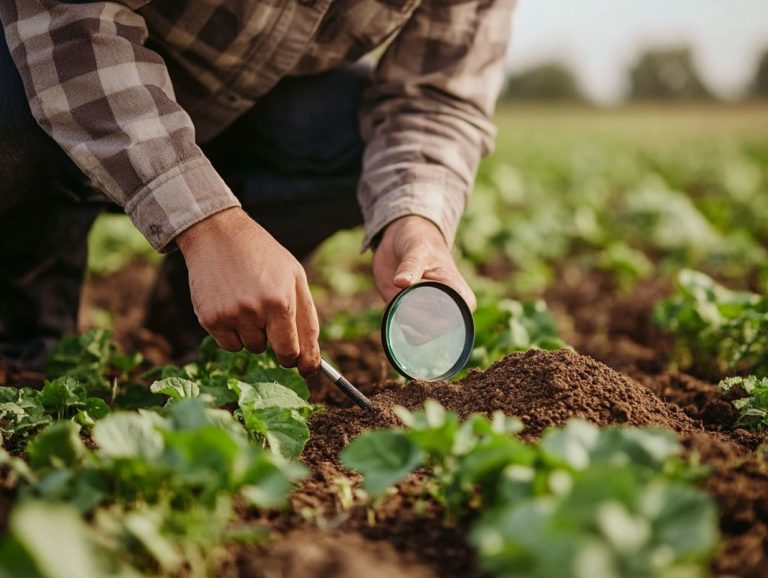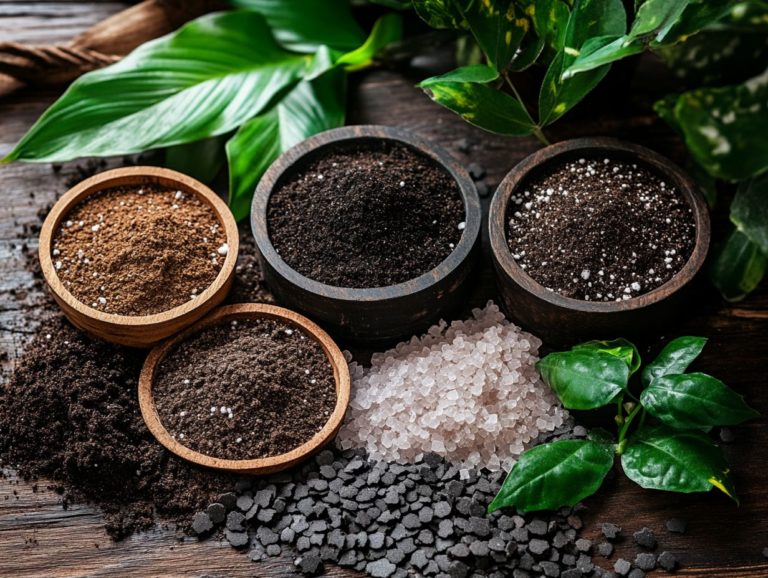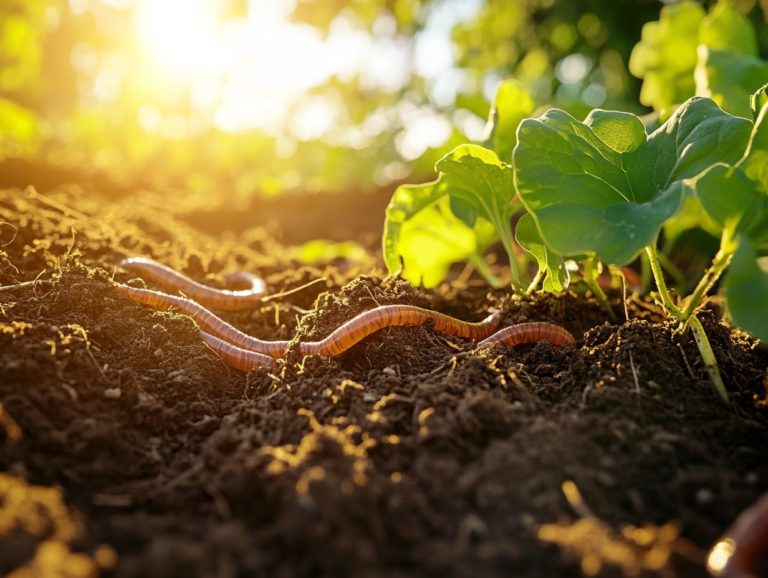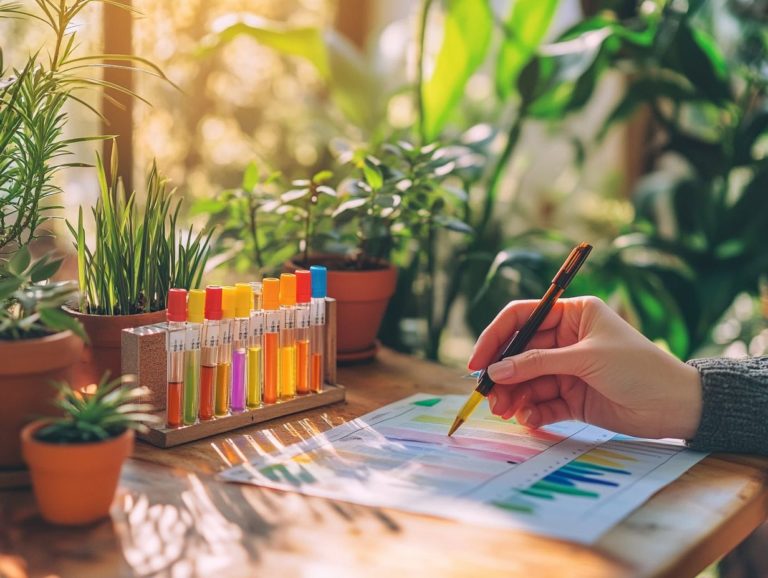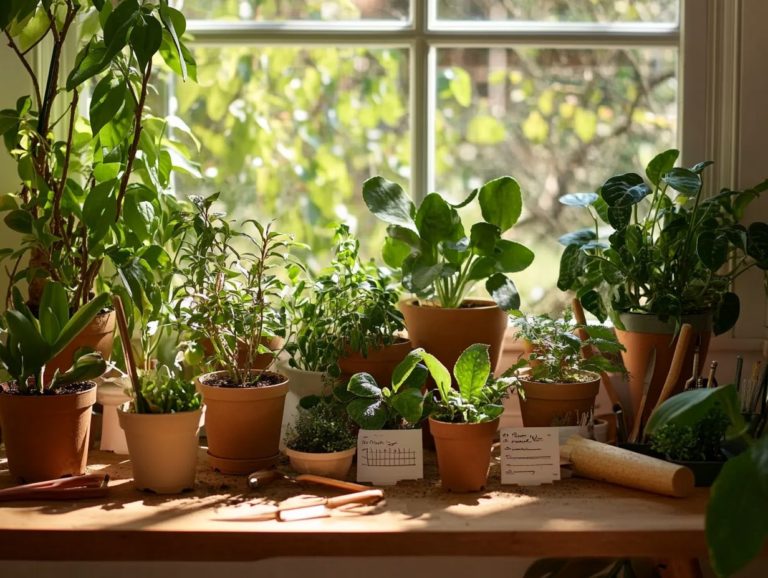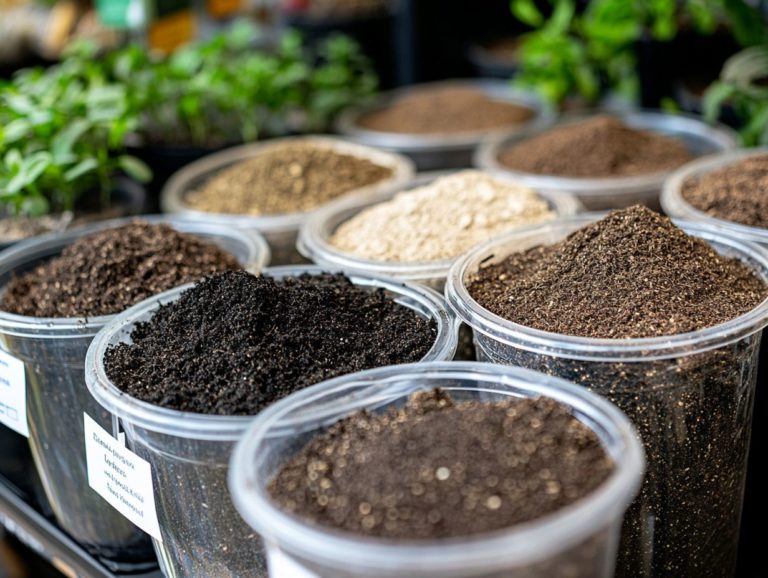10 Tips for Maintaining Indoor Plant Soil
Creating a thriving indoor garden begins with the foundation of healthy soil. Whether you re an experienced plant enthusiast or just embarking on your botanical journey, grasping the nuances of soil health is paramount.
From selecting the ideal soil type to vigilant pest monitoring, you ll find ten essential tips that will help your indoor plants thrive.
Explore indicators of unhealthy soil and the benefits of opting for organic solutions, along with common pitfalls to steer clear of.
Immerse yourself in this knowledge to elevate your indoor oasis to new heights!
Contents
- Key Takeaways:
- 1. Choose the Right Type of Soil
- 2. Use a Pot with Drainage Holes
- 3. Water Properly
- 4. Fertilize Regularly
- 5. Monitor for Pests and Diseases
- 6. Re-Pot When Necessary
- 7. Use Mulch
- 8. Avoid Overcrowding
- 9. Use a Moisture Meter and Gardening Tools
- 10. Rotate Your Plants
- How Often Should Indoor Plant Soil Be Changed?
- Frequently Asked Questions
- What are some tips for maintaining indoor plant soil?
- What type of potting soil should I use for indoor plants?
- How often should I water my indoor plants and what watering schedule should I follow?
- How do I know if I am overwatering my indoor plants and what signs to look for?
- Why is it important to fertilize indoor plants and how does it benefit their growth?
- How do I prevent pests from infesting my indoor plants and maintain a healthy environment?
Key Takeaways:
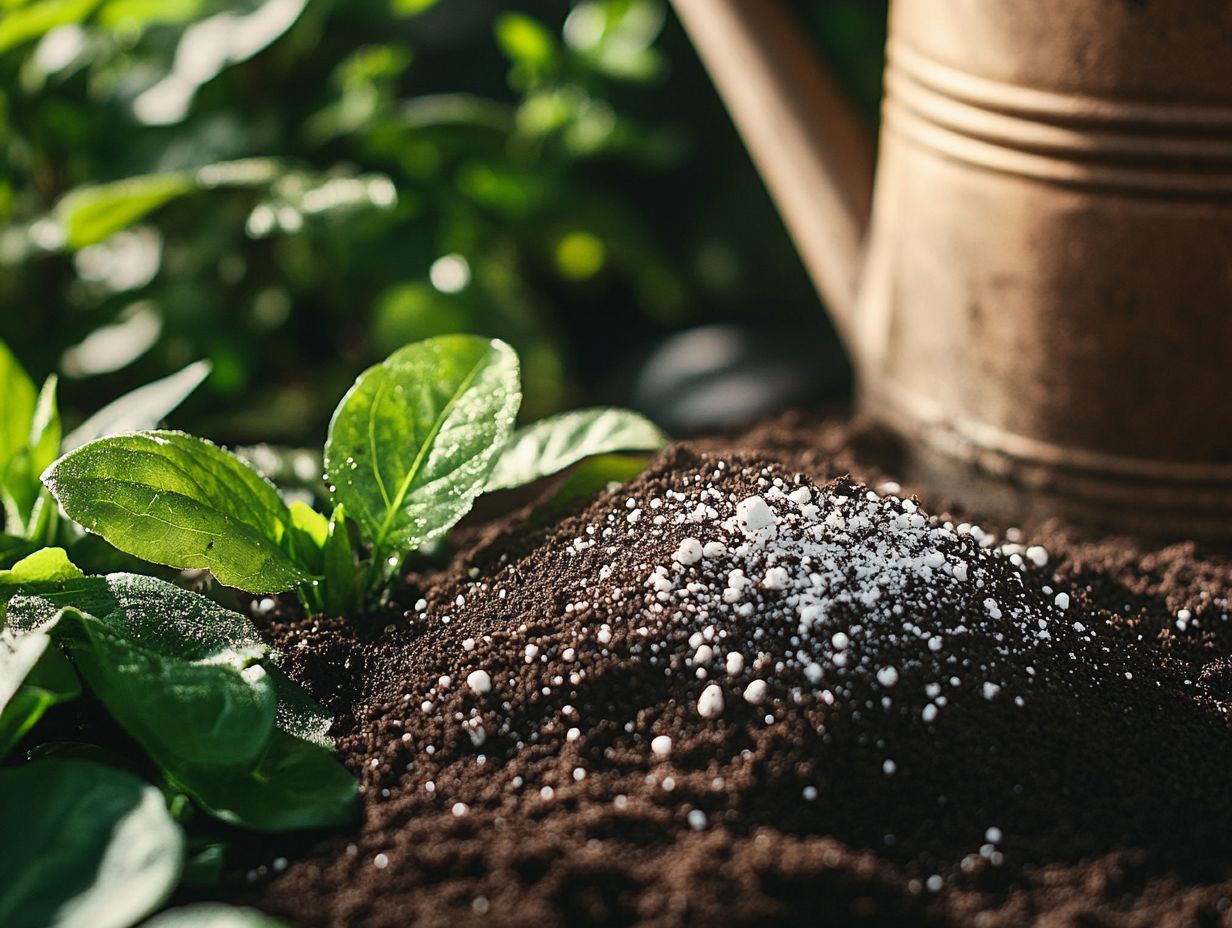
- Choose the right type of soil to match the needs of your indoor plants.
- Use pots with drainage holes to prevent water from accumulating and causing root rot.
- Proper watering techniques, including allowing the soil to dry out slightly between waterings, can help maintain healthy soil for indoor plants.
1. Choose the Right Type of Soil
Choosing the right type of soil is essential for nurturing healthy growth in your houseplants. It provides the nutrients and moisture they need to thrive in various indoor gardening settings.
A high-quality potting mix can profoundly impact plant health by ensuring optimal drainage and aeration for robust roots.
For instance, consider organic soil. It’s brimming with beneficial microorganisms and essential nutrients, making it a fantastic choice for houseplants like Ficus umbellata, which thrive in a nutrient-rich environment.
Conversely, succulents such as Echeveria prefer a well-draining potting mix that prevents overwatering crucial for their survival.
Factors like how well the soil holds water and nutrient availability differ across soil types, directly influencing a plant’s growth patterns. By understanding these characteristics, you can tailor your soil selection to meet the specific needs of each plant variety.
Ultimately, this will lead to a flourishing indoor garden that will impress anyone who steps through your door.
2. Use a Pot with Drainage Holes
Using a pot with drainage holes is crucial for nurturing healthy roots in your houseplants. It prevents water from pooling at the bottom, which can lead to root rot and other issues that could hinder growth.
Proper drainage is key because it directly impacts moisture levels in the soil, which affects how well your plants absorb nutrients and maintain their overall health.
For example, flowering plants like African violets and leafy ferns flourish in well-draining pots, allowing excess water to escape and keeping their roots from becoming waterlogged.
If you start noticing signs that a plant is pot-bound when a plant is pot-bound, it means the roots have no space to grow because they have filled the pot such as stunted growth or roots pushing out of the drainage holes, it might be time to give your plants a new home!
3. Water Properly
Proper watering practices are essential for the health of your indoor plants, as each species has its own specific needs when it comes to moisture levels and watering frequency.
Some plants flourish in higher humidity, while others require meticulous attention to their watering schedule to avoid issues like root rot.
To create an effective watering schedule, consider the natural environment of your plants. For example, tropical plants might crave more frequent watering compared to succulents, which are perfectly adapted to drier climates.
If you re using chlorinated water, let it sit for 24 hours to allow harmful chemicals to dissipate, minimizing their impact on your plants’ sensitive root systems.
Monitoring the humidity levels in your home is crucial. Higher humidity can mean less frequent watering, while drier air may require you to step up your moisture game to keep your plants healthy and thriving. Check your humidity levels regularly your plants are counting on you!
4. Fertilize Regularly
Regular fertilization is essential for your indoor plants. It ensures they receive important nutrients for robust growth.
Even high-quality potting mixes can deplete nutrients over time. Identify the right types of fertilizers and establish effective schedules.
Understanding organic and synthetic fertilizers can enhance your care routine. Organic options release nutrients gradually and improve soil structure.
Synthetic fertilizers offer quick results, but they can lead to salt buildup if not applied carefully.
Recognize signs of nutrient deficiency, like yellowing leaves or stunted growth. This will help you adjust your fertilization strategy effectively.
5. Monitor for Pests and Diseases
Monitoring your indoor plants for pests and diseases is a must for keeping your plants healthy. Infestations, like spider mites, can spread rapidly and lead to unhealthy plants if not addressed promptly.
Other common offenders include aphids, mealybugs, and scale insects, each bringing distinct signs, such as yellowing leaves, sticky residue, or visible webs. Conduct regular inspections to maintain a clean growing space to prevent these issues.
Keep leaves free from dust to enhance photosynthesis and deter pests. Establishing a consistent watering routine and providing suitable light conditions can further reduce stress and vulnerability in your plants, enabling them to better resist pests and diseases.
6. Re-Pot When Necessary

Don t wait re-pot your houseplants as soon as they need it to keep them thriving! Re-potting is essential for ongoing growth and health, especially when plants become pot-bound.
This condition can hinder their ability to absorb nutrients and moisture, ultimately impacting their overall vitality. Keep an eye out for signs such as roots pushing through drainage holes or a noticeable decline in growth, even with proper care these are clear indicators that a change is due.
If the soil looks compacted, retains too much water, or has a sour smell, it s a strong sign that the plant s environment is not supporting its well-being.
When selecting a new pot, choose one that s slightly larger to accommodate future growth. As for potting soil, opt for a mix tailored to your plant’s specific needs.
Whether it’s a well-draining mix for succulents or a moisture-retentive blend for tropical varieties, this consideration is key to ensuring optimal health and flourishing growth.
7. Use Mulch
Incorporating mulch into your indoor gardening approach can offer remarkable benefits for your houseplants. It plays a vital role in retaining moisture, regulating soil temperature, and providing additional nutrients as it decomposes, all of which fosters a thriving environment for growth.
You have a variety of mulch options at your disposal coconut coir, bark chips, and even decorative stones each tailored to meet the specific needs of your indoor plants. For example, coconut coir not only retains moisture effectively but also enhances soil aeration, which is essential for robust root health.
By applying mulch right after watering, you can successfully lock in moisture. It’s advisable to refresh it every few months to ensure it remains effective. Timing your mulch application during your plant s active growing season will yield optimal results, allowing both the soil and your plants to flourish in perfect harmony.
8. Avoid Overcrowding
Avoid overcrowding in your houseplant collection. Each plant needs enough light, air circulation, and nutrients for healthy growth. This attention to detail can lead to thriving indoor plants.
When plants are crammed together, they compete for resources and create a humid environment that fosters mold and pests. To prevent these issues, arrange your plants thoughtfully. Start by selecting a location with ample natural light, and consider the height and spread of each plant.
Place shorter plants near windows and position taller varieties closer to the light source. This way, every plant gets the sunlight it craves. Leaving gaps between pots enhances airflow, reduces humidity, and minimizes the risk of disease. This promotes the health and growth of your indoor garden.
9. Use a Moisture Meter and Gardening Tools
Using a moisture meter is an invaluable strategy for you as a plant parent. It helps you monitor soil moisture levels accurately, ensuring your indoor plants receive the right amount of water.
A moisture meter measures how much water is in the soil, helping you avoid the pitfalls of overwatering and underwatering. With consistent monitoring, you can create a watering schedule that fits each plant species in your care.
Top moisture meters, like the Ecowitt Soil Moisture Sensor and the XLUX Soil Moisture Meter, stand out for their reliability and user-friendly design. Both deliver quick readings and are built to last, making them excellent tools for anyone eager to cultivate their green space while ensuring proper plant care.
10. Rotate Your Plants
Rotate your houseplants regularly to ensure every side gets equal light. This simple technique promotes uniform growth and prevents issues like leggy stems and unhealthy roots.
By making rotation a habit, you can nurture a vibrant indoor garden that enhances your living space. Think about the type of plant when deciding how often to rotate. Fast-growing varieties like pothos may need a weekly spin, while slower-growing plants like Ficus umbellata could be fine with a bi-weekly or monthly turn.
Position your plants to capture natural light effectively. Finding a routine that works for both you and your plants will lead to a flourishing collection that brings joy to your home.
How Often Should Indoor Plant Soil Be Changed?
Changing the soil for your indoor plants is a crucial practice. Guidelines suggest refreshing the soil every 12 to 18 months. This helps replenish nutrients and maintain moisture for your houseplants.
Factors like plant type, growth stage, and the condition of the potting mix can influence how often you should change the soil. Fast-growing species, such as ferns and pothos, might deplete nutrients quicker, so you may need to change the soil more often.
Younger plants, which have higher nutrient demands, might benefit from an earlier refresh compared to established plants. Look for signs indicating it s time for a soil renewal, like water pooling on the surface or unpleasant odors.
To extend the life of your soil, mix in organic compost regularly. This practice ensures a steady supply of nutrients and improves soil structure, giving your plants the best foundation to thrive.
What Are the Signs of Unhealthy Soil?

Recognizing the signs of unhealthy soil is essential for maintaining your houseplants. Symptoms like poor drainage and root rot can seriously affect plant health and demand your immediate attention.
You might also notice other indicators, such as stunted growth or yellowing leaves. An increase in pest infestations can also be a warning sign. A gritty or compacted soil texture may indicate compaction issues.
The presence of fungal growth or unpleasant odors often points to overwatering or a lack of air circulation. These symptoms suggest that the soil ecosystem is out of balance and that amendments are necessary.
To restore soil health, consider incorporating organic matter like compost to boost nutrient content and improve drainage. Regular soil testing can help you determine specific amendments.
Additionally, rotating your plants can assist in breaking pest cycles. Act now to check your soil health! Your plants depend on it!
What Are the Benefits of Using Organic Soil?
Using organic soil in your indoor gardening can elevate your experience. Imagine your plants thriving in rich organic soil! It s not just good for them; it s also great for our planet!
- Enhanced nutrient availability
- Improved moisture retention
- Healthy root development
Organic soil also supports the health of the ecosystem. By incorporating natural matter and steering clear of synthetic chemicals, you can nurture a sustainable environment that supports biodiversity.
Consider brands like FoxFarm and Miracle-Gro Organic Choice. They offer high-quality potting mixes brimming with beneficial microbes and organic matter. These products promote robust plant growth and enhance soil structure.
Ultimately, opting for organic soil does more than nourish your plants; it aligns your gardening practices with a commitment to environmental stewardship. Check your soil today to ensure your plants are happy and healthy!
Can Indoor Plants Survive Without Soil?
Indoor plants can thrive without traditional soil, thanks to innovative methods like hydroponics and aeroponics. Hydroponics is growing plants in water with nutrients, while aeroponics is growing plants in air with a spray of nutrients.
These techniques rely on nutrient-rich water solutions or mist to support plant growth and development. You ll find these approaches gaining traction among enthusiasts and commercial agriculture.
They promise higher yields and faster growth rates. Hydroponics typically involves cultivating plants in a controlled environment with water mixed with essential nutrients, making it perfect for leafy greens like lettuce and herbs.
Aeroponics takes it a step further by suspending plants in the air. This method delivers nutrients through a fine mist, which works wonders for fruits like strawberries and peppers.
Both methods significantly reduce the need for pesticides and can conserve water. Of course, they come with their own set of challenges, such as the technical expertise required to maintain these systems and the higher initial setup costs.
What Are Some Common Mistakes When It Comes to Indoor Plant Soil?
Many plant parents often stumble into common pitfalls when it comes to indoor plant soil. Using the wrong type of potting soil or neglecting to check moisture levels can lead to unhealthy roots and stunted growth.
It s crucial for you to understand the specific needs of your greenery. Opting for a high-quality potting mix tailored for indoor plants can significantly improve soil drainage and aeration.
Regular moisture checks, possibly with the aid of a moisture meter, enable you to establish precise watering schedules, effectively preventing both over and underwatering.
Incorporating organic fertilizers during the growing season can help replenish essential nutrients, creating a lush environment for healthy growth. By remaining informed and proactive, you can transform your indoor spaces into flourishing green havens filled with vibrant houseplants. Additionally, understanding how to amend soil for indoor plant growth is crucial for optimal results.
How Can One Create a Healthy Soil Environment for Their Indoor Plants?
Creating a healthy soil environment for your indoor plants starts with selecting the right potting mix and ensuring adequate moisture levels. Routinely assess nutrient availability to promote robust growth and healthy roots.
To elevate your plant care game, consider using composting techniques that boost soil fertility. Adding well-decomposed organic materials like kitchen scraps and shredded leaves enriches your potting mix with essential nutrients and enhances drainage. Additionally, you may find 5 tips for watering low-light plants helpful in keeping your plants thriving.
Mixing in these organic elements regularly helps create a balanced ecosystem that nurtures beneficial microorganisms. Maintaining appropriate moisture levels is crucial; both overwatering and underwatering can jeopardize delicate root systems.
By evaluating your soil conditions and adjusting your watering schedule according to your plants needs, you can create a thriving, nutrient-rich environment that keeps your indoor garden flourishing and supports the overall health of your houseplants collection.
This video provides further insights into creating a healthy soil environment for your indoor plants.
Frequently Asked Questions
What are some tips for maintaining indoor plant soil?

Want your indoor plants to thrive? Try these 10 easy tips to keep their soil healthy:
- Use high-quality potting mix designed for indoor plants.
- Ensure proper drainage with pots that have holes or by adding rocks at the bottom to prevent root rot.
- Water your plants regularly, but avoid overwatering. Consider using a simple tool to check how wet the soil is.
- Monitor humidity and temperature levels in your home, adjusting as necessary for your plants.
- Rotate your plants for even exposure to natural light.
- Fertilize indoor plants with balanced fertilizer every 2-3 months for essential nutrients.
- Regularly prune dead or yellow leaves to maintain plant health.
- Clean leaves often to prevent dust buildup and promote healthy roots.
- Check for pests like spider mites and treat them immediately if found.
- Repot every 1-2 years to refresh potting soil and give plants more space to grow.
What type of potting soil should I use for indoor plants?
Use nutrient-rich potting soil specifically crafted for indoor plants. These soils are designed to hold moisture and provide necessary nutrients for your plants, including cacti and succulents, to thrive.
How often should I water my indoor plants and what watering schedule should I follow?
The frequency of watering depends on the type of plant, such as Ficus umbellata or ZZ plant, the size of the pot, and the humidity in your home. Generally, watering once a week is a good guideline, but always check soil moisture using a simple tool before watering.
How do I know if I am overwatering my indoor plants and what signs to look for?
If the soil feels constantly wet or if the leaves are yellowing and wilting, you might be overwatering. Ensure your pot has drainage holes and let the soil dry out between waterings.
Why is it important to fertilize indoor plants and how does it benefit their growth?
Fertilizing provides essential nutrients for your indoor plants to grow. Tropical varieties like Clivia and orchids can quickly deplete soil nutrients, so fertilizing every 2-3 months helps replenish them.
How do I prevent pests from infesting my indoor plants and maintain a healthy environment?
To prevent pests, check your houseplant collection regularly for signs of infestation. Treat any issues immediately, and consider using natural pest control methods like neem oil or insecticidal soap for a healthy plant environment.
With these tips, you re all set to grow a vibrant indoor garden that flourishes!

